Hey, if your garden gets barely any sun, don’t worry, you’ve got options. Shade-loving plants can transform those dim corners into lush, green spaces. Start by evaluating your area—does it get less than 4 hours of direct light daily? Stick around, and I’ll break down some top picks, like hostas and ferns, with exact tips to make your shady spot thrive. Curious about the best choices?
Contents
Hostas Thrive in Shade
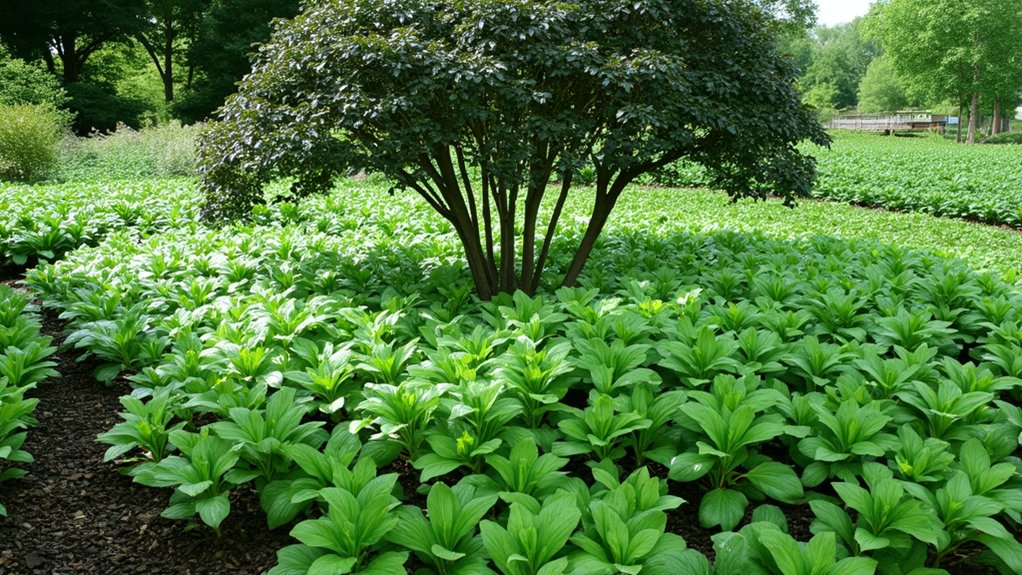
Although gardening in shaded areas can seem tricky, hostas are a fantastic choice to bring life to those dim spots. You’ve got a plant here that’s tough, versatile, and thrives with minimal sun. Let’s get your garden popping with these leafy beauties.
Start by picking a spot with dappled shade, ideally under trees or near buildings. Hostas prefer soil that’s rich, moist, and well-drained, so mix in compost if yours is lacking. Plant them 1-2 feet apart, depending on the variety, with the crown just at soil level. Water them deeply, about 1 inch per week, especially in dry spells.
Check for slugs, as they’re pesky and love hostas. Use traps or barriers if you spot them. There, you’re set for lush, shady growth!
Ferns Love Shady Spots
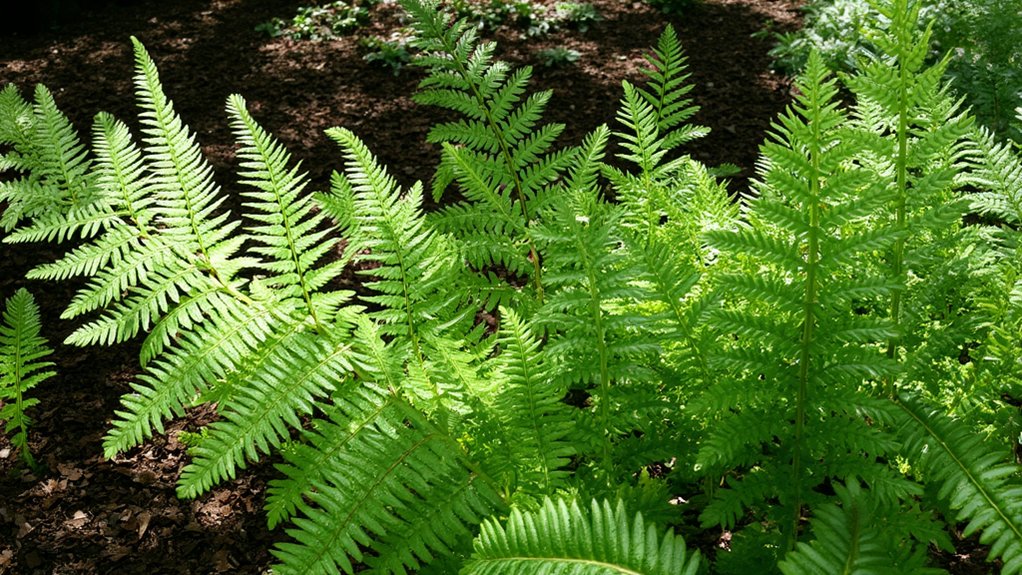
Countless ferns can transform your shady garden into a lush, green haven. You’ll find these plants thrive where sunlight barely sneaks through, adding texture with their feathery fronds. They’re low-maintenance, so you won’t stress over them.
Start by picking a spot with moist, well-drained soil, ideally under a tree canopy. Plant ferns like the Autumn Fern or Lady Fern, spacing them 12-18 inches apart for good air flow. Water them regularly, aiming for 1 inch per week, especially in dry spells, to keep soil damp but not soggy.
Check for pests monthly; if you spot any, use a mild soap spray to tackle them fast. With these steps, you’ve got a thriving, green corner in no time.
Astilbe Brightens Shady Areas

If you’re looking to add a splash of color to your shady garden, Astilbe is your go-to plant. It’s a perennial that thrives in low light, offering feathery plumes of pink, red, or white flowers. You’ll love how it brightens dim corners with minimal effort.
Plant Astilbe in well-drained, moist soil, ideally with a pH of 6.0 to 6.5. Space them about 18 to 24 inches apart, ensuring they’ve got room to spread. Water regularly, aiming for about 1 inch per week, especially in dry spells.
Expect blooms from late spring to early summer, lasting several weeks if you’re consistent with care. Trim dead foliage in fall, and you’ll see healthy growth return each year. Easy, right?
Bleeding Heart’s Shady Charm
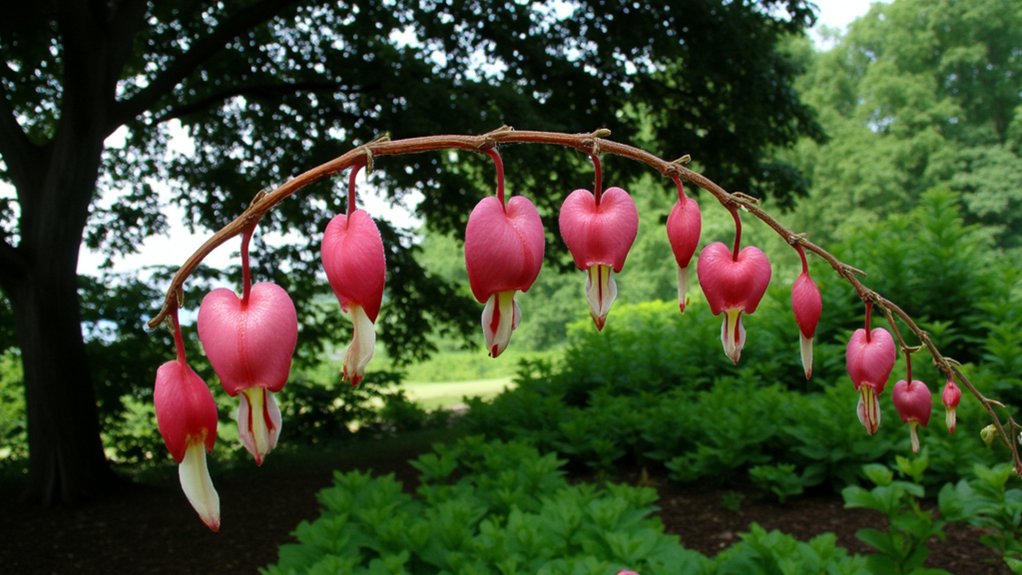
Hey there, let’s talk about Bleeding Heart, a real gem for shady spots in your garden. You’ll love how its unique, heart-shaped flowers dangle delicately, adding charm to dim corners. They bloom in spring, typically April to May, with pink or white petals.
Plant them in well-drained, moist soil, about 1-2 feet apart, to give roots space. Dig a hole twice the bulb’s size, place it in, and cover gently. Water regularly, aiming for 1 inch weekly, but don’t let it get soggy.
Choose a spot with partial to full shade, as direct sun can scorch them. With heights of 1-3 feet, they’re perfect near walkways or under trees. Keep an eye out for slugs; a quick check weekly helps.
Impatiens Adore Dim Gardens
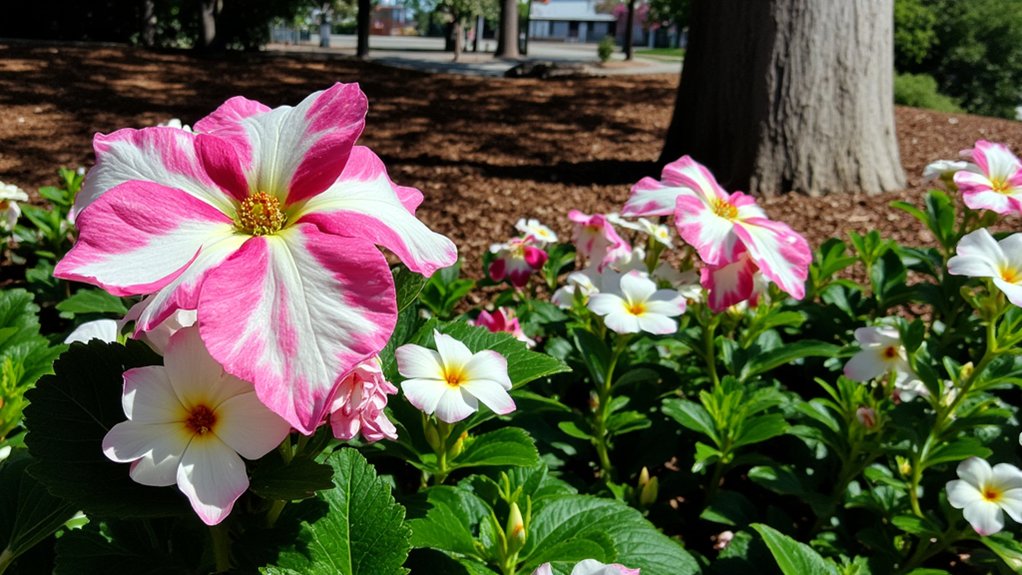
While exploring shade-loving options, let’s plunge into Impatiens, a fantastic pick for dim garden areas. You’ll love how these plants thrive in low light, adding pops of color.
Plant Impatiens in spots getting less than 4 hours of direct sun daily. They prefer moist, well-drained soil, so mix in compost before planting, and water them every 2-3 days if rainfall’s scarce. Space them 8-12 inches apart to avoid overcrowding.
You can start seeds indoors 8-10 weeks before the last frost, or buy young plants for quicker results. Pinch off dead blooms to keep them looking tidy and encourage growth. With heights of 6-24 inches, depending on the variety, they’re perfect for borders or containers in your shady garden nooks.
Heuchera’s Shady Elegance
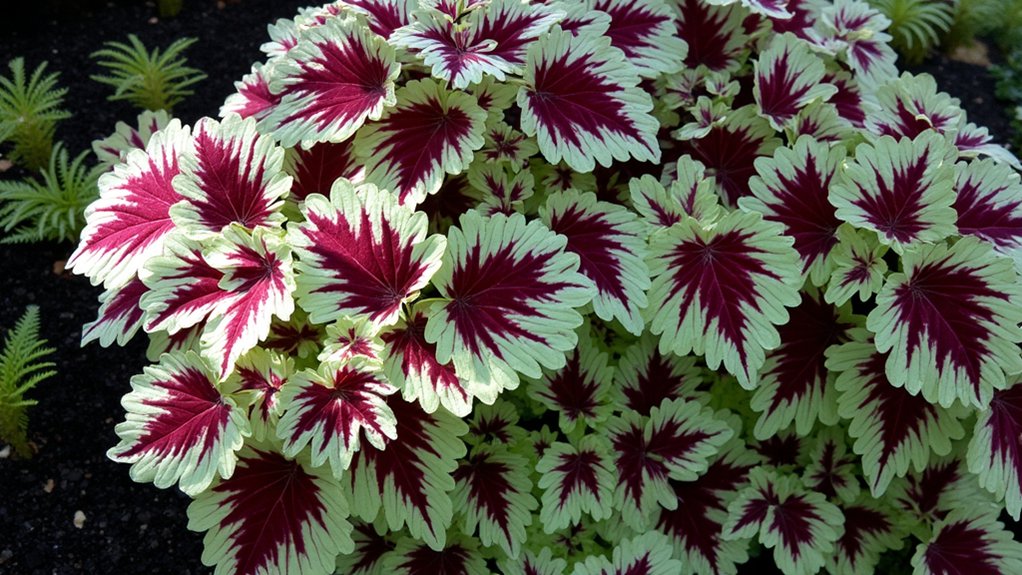
Let’s shift our focus to Heuchera, a stunning choice for shady spots with its elegant, colorful foliage. You’ll love how these plants, often called coral bells, brighten dim areas with leaves in shades of purple, silver, or lime green. They’re perfect for borders or containers.
Plant Heuchera in well-drained soil, ideally with a pH of 6.0 to 7.0, and space them about 12-18 inches apart. Water them regularly, aiming for 1 inch per week, especially during dry spells, but don’t let the soil get soggy. They thrive in partial to full shade, so pick a spot with 2-4 hours of filtered light daily.
Prune dead leaves in early spring, around March, to keep them tidy. Trust me, you’ve got this!
Lilyturf’s Shady Resilience
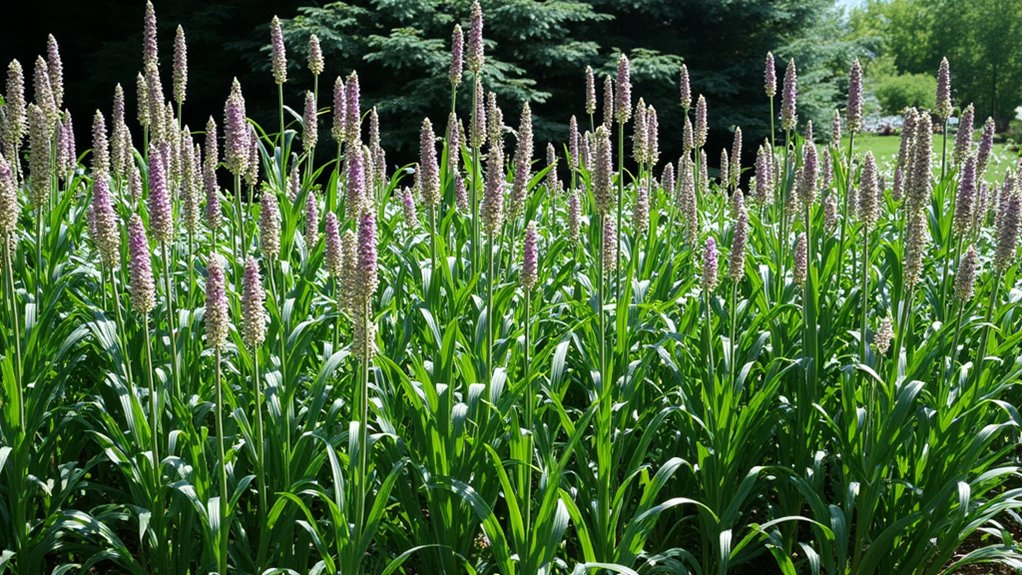
As we turn to another shade-loving gem, meet Lilyturf, or Liriope, a tough, resilient plant for your garden’s darker corners. You’ll love how this grass-like perennial thrives in full to partial shade, needing little fuss. It’s perfect for borders or ground cover, growing 12-18 inches tall.
Here’s how you can plant it: first, choose a spot with well-drained soil, ideally in early spring. Dig a hole twice the root ball’s width, about 6 inches deep, and place the plant in. Backfill with soil, water it well, and mulch around the base to retain moisture.
Lilyturf’s durability means it handles drought once established, so you’re not stuck watering constantly. Expect small, purple flower spikes in late summer, adding subtle charm.
Begonia’s Shady Beauty
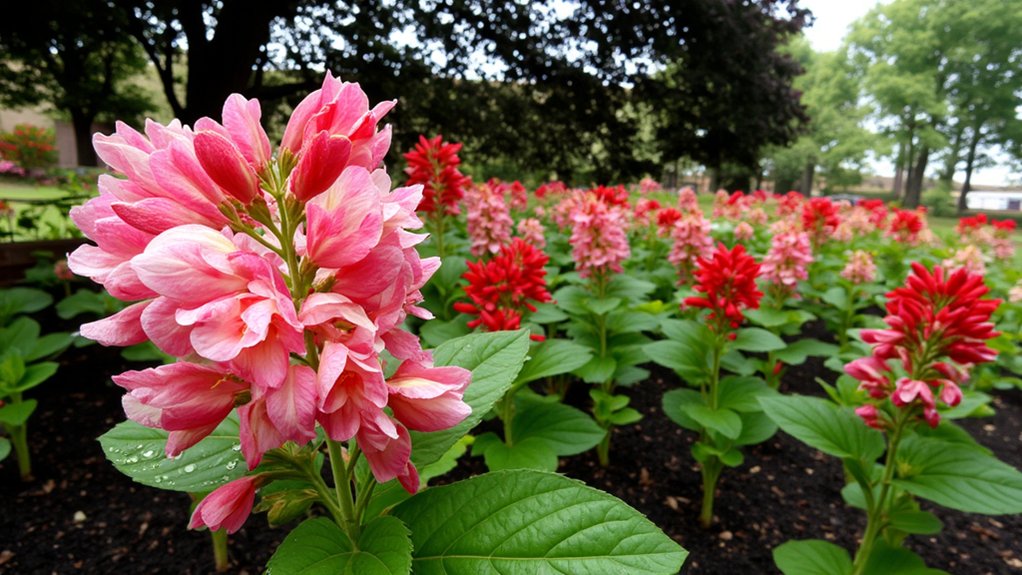
Moving on to another shade-loving star, check out Begonias, a vibrant option for your garden’s dim spots. They’re perfect if you’ve got areas with filtered light or full shade, and they’ll add pops of color without much fuss.
Plant Begonias in well-draining soil, ideally with a pH of 5.5 to 6.5, to keep them thriving. Space them about 12 inches apart, ensuring they’ve got room to spread, and water them every 2-3 days if the soil feels dry. Don’t overdo it, though—soggy roots can spell trouble.
You’ll see blooms from late spring to fall if you deadhead spent flowers regularly. Place them under trees or on shaded patios, and watch your garden transform with minimal effort on your part.
Caladium’s Shady Vibrance
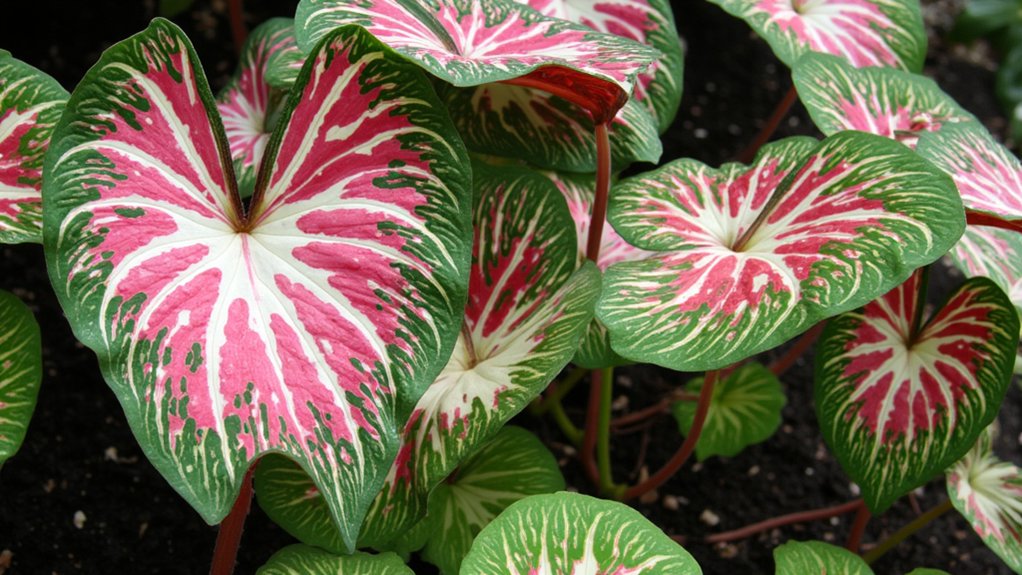
Check out Caladiums, another fantastic pick for those shady garden corners begging for life. They’re known for their vibrant, heart-shaped leaves, often splashed with reds, pinks, and whites. You’ll find these tropical beauties thrive in partial to full shade, so they’re perfect for dim spots.
Want to grow them? Plant Caladium tubers 2 inches deep in well-drained, moist soil, ideally in spring after the last frost. Space them about 8-12 inches apart, and guarantee the area gets no more than 2-3 hours of indirect sunlight daily. Water consistently, keeping soil damp but not soggy, roughly 1 inch per week.
Watch them sprout in 2-4 weeks, adding bold color to your garden. They’ll last until fall, then store tubers indoors for next year.
Toad Lily’s Shady Splendor
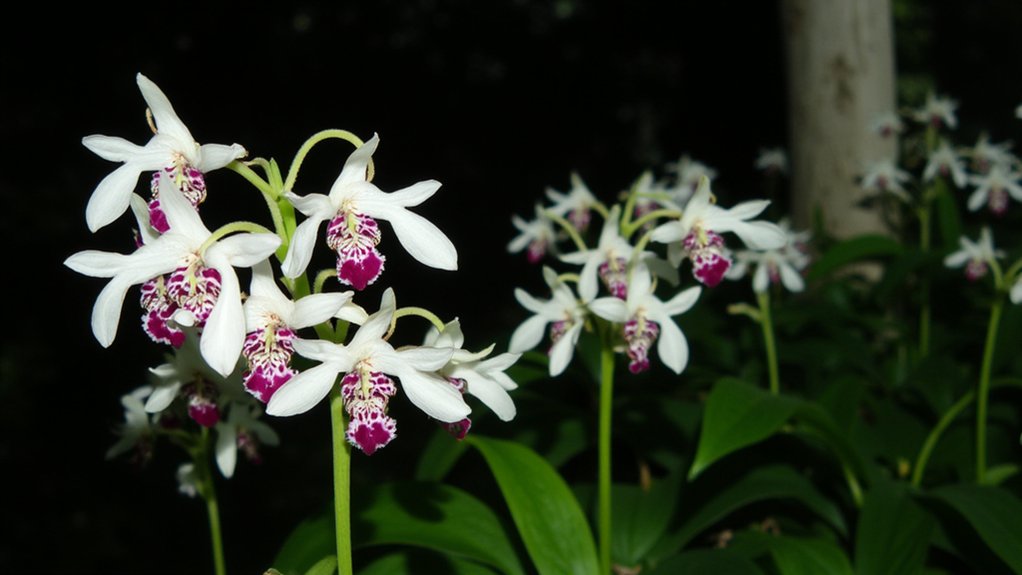
Dive right into the charm of Toad Lilies, a stellar choice for your shady garden nooks. These unique perennials, with their speckled, orchid-like blooms, thrive in partial to full shade. You’ll love how they add a subtle pop of color, especially in late summer to early fall.
Start by planting them in well-drained, rich soil, about 2-3 inches deep. Space the bulbs 12-18 inches apart to give them room to spread. Water them moderately, keeping the soil consistently moist, but don’t let it get soggy.
Place them under trees or near taller shrubs for natural protection. Check for growth in late spring; they’ll reach about 2-3 feet tall. With minimal care, you’ve got a quirky, shade-loving gem in your garden!
